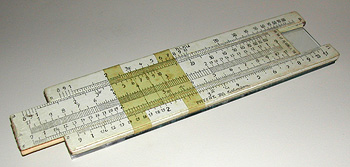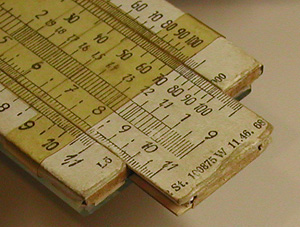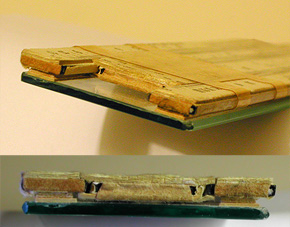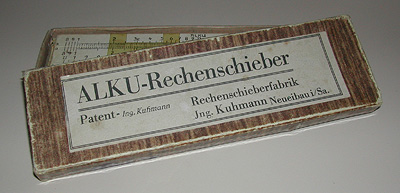 |
|
|
|

|

|
Glass and Paper ?!? |
|
|
|
|
Slide Rules were built to stand daily use for an engineer’s lifetime; they were therefore made from durable materials, whether wood, metal or plastic. I have one exception, but it's a whopping big one: a slide rule made of glass. | |
|
|
|
This is the ALKU. It’s a simple one-sided 7-inch slide rule, manufactured by the eponymous Ing. Alfred
Kuhmann of Neueibau, a town in the south of (then) East Germany. It was made in his slide rule factory in the immediate
post-war era, in the second half of the 1940’s.
At first glance, this instrument seemed to be made of three thick |
 Click photo to enlarge |
|
|
|
cardboard strips, the outer two (comprising the slide rule’s stator) glued to a glass baseplate, and the central one sliding between them through an elaborate tongue-and-groove setup made from thinner cardboard strips on which the scales are printed. Only later did I notice that the thick strips are themselves made of glass, which is coated on all sides with cardboard and paper, but shows through where the paper has worn out at the corners. The scales, printed on the top cardboard layer of this sandwich structure, form a standard simplex A [B, CI, C] D arrangement. They are all extended beyond the 1 mark at both ends, which in the absence of the red color usually applied to the extension on other rules is rather confusing to use. Click the photos for a close-up view. | |
|
|
|
Clearly, Ing. Kuhmann ran a tight Rechenschieberfabrik –- there are three Quality Control
stamps on the bottom (and a sticker I added to protect a crack in the glass...)
Below you can see the details of this unusual construction. Note the extra layer of cardboard between the baseplate and the stator, added to provide a little spacing so the slide won’t touch the glass. |

 Click a photo to enlarge |
|
|
|

 Click a photo to enlarge |
|
|
|
|
Here is the neat cardboard box the slide rule came in, slightly scuffed but in good shape
(As we saw, this factory knew its way around applying cardboard...) There is also a modest instruction leaflet, which you can see by clicking here: Page 1 Page 2. |

|
|
|
|
The big question is, why would they use glass and paper? One can only guess, and the likely reason would be post-war shortages. This slide rule was made around 1947; it is quite likely that the woods used in this industry (carefully selected for long-term dimensional stability) were not readily available in East Germany at that time, and perhaps neither was the machining equipment needed to produce metal slide rule parts. But plate glass is abundant, is flat and dimensionally stable, and can be cut to fairly good precision. Alfred Kuhmann may have been practicing my favorite definition of Engineering: “The art of making what you want from things you can get”. He wanted to produce slide rules; he made them from things available to him in a difficult time. He did a remarkably good job too –- his glass slide moves more smoothly than those of many higher-end wooden rules I have from the same period. And his cursor, made from a bent piece of (apparently) celluloid film, is just as effective.
Exhibit provenance:
More info: |
|
|
|
|
|
|
|
|
|
Home | HOC | Fractals | Miscellany | About | Contact Copyright © 2006 N. Zeldes. All rights reserved. |
|